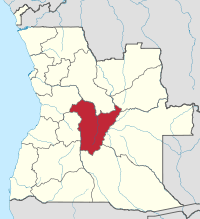Bié Province
| Bié | |
|---|---|
| Province | |
 Bie, province of Angola | |
| Country | Angola |
| Capital | Kuito |
| Area | |
| • Total | 70,314 km2 (27,148 sq mi) |
| Population (2014 census) | |
| • Total | 1,338,923 |
| • Density | 19/km2 (49/sq mi) |
| ISO 3166 code | AO-BIE |
| Website |
www |
Bié is a province of Angola located on the Bié Plateau in central part of country.[1] Its capital is Kuito, which was called Silva Porto until independence from Portugal in 1975. The province has an area of 70,314 square kilometres (27,148 sq mi) and a population of 1,338,923. Municipalities in the province include Andulo, Camacupa, Catabola, Chinguar, Chitembo, Cuemba, Cunhinga, Kuito, and Nharea. The current governor of Bié is José Amaro Tati.
Overview
Bié has boundaries with the province of Malanje, to the northeast with the province of Lunda Sul, to Moxico, to the south with Cuando Cubango and to the west with the provinces of Huila, Huambo and Cuanza Sul.
The climate of Bié is fresh and abundant rainfall makes possible the culture of corn, sugar cane, rice, coffee and peanuts. Its ground known to be one of the most fertile in Angola.
Bié is furrowed to east and north from the Cuanza River, that sliding towards north, marks part of the border with Malanje. The south-west is furrowed from the river Cuchi, an affluent of river Cubango.
The province was once an important commercial link between the Portuguese traders at the port of Benguela on the Atlantic Ocean and the Afri-Portuguese and Ovimbundu at the interior of the country. The capital and other cities in the province remain important commercial centers in Angola.[1]
Origins of Jonas Savimbi
Bié province is perhaps best known as the place where the family of Angolan political leader Jonas Savimbi came from. Savimbi, although born in Moxico Province near Bié, was ethnically Bieno, i.e. of a subgroup of the Ovimbundu. He led the UNITA movement first in the anti-colonial war against the Portuguese, and then in the Civil War against the ruling MPLA before he was killed in combat in 2002. Savimbi gained global notoriety as a United States ally during the Cold War.
Civil War
Bié is one of the regions that was heavily affected by the Civil War. Agriculture came to a halt in several areas, and part of the rural population fled to the cities. The province capital Kuito was in part destroyed by bombing, as were roads and other infrastructures. Since 2002, reconstruction efforts have been important, but as of early 2011 much remained to be done.
References
External links
- Official website of province governor
- Information on this province at the Angolan ministry for territorial administration
- Information on this province at Info Angola
- US government statistics from 1988
- Province geographical info at geoview.info
Coordinates: 12°31′S 17°34′E / 12.517°S 17.567°E